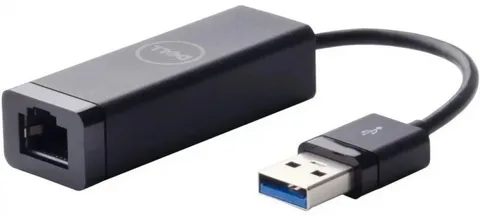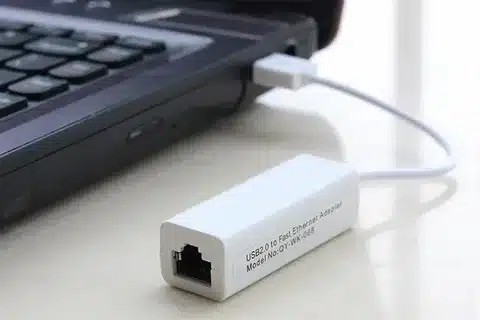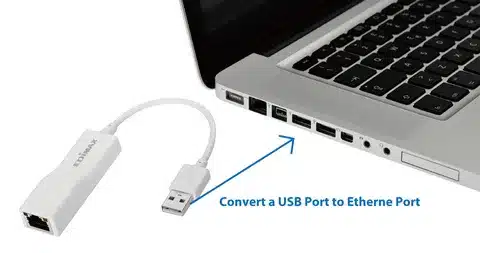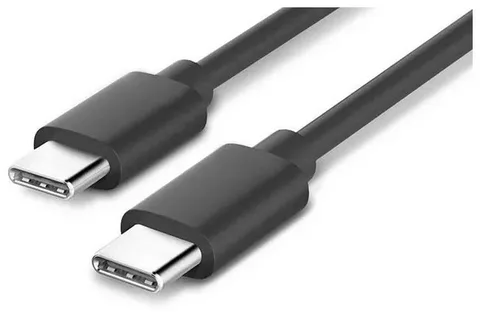Ever missed an important video call because your Wi-Fi went for a coffee? Or had your gaming session grind to a halt as it became a slideshow due to wireless interference? You’re not alone. While Wi-Fi is convenient, it isn’t always reliable when you need it most. And then, you get a USB-to-Ethernet adapter that saves you from the internet.
Why Switch from Wi-Fi to Ethernet with a USB Adapter?

Convenience is completely trumped by stability here. Ethernet connections offer consistent speeds without the drops, lag spikes, and interference that wireless networks struggle with.
Speed and consistency. Wired connections have none of the signal degradation that Wi-Fi can suffer from, particularly over busy networks or buildings with thick walls. You’ll receive the full bandwidth that you paid for on your internet service.
Perfect for demanding tasks. Ethernet offers a highly stable connection that is ideal for gaming, video streaming, video conferencing, and transferring large files. No more buffering while delivering key presentations stable internet connection.
Eliminates dead zones. The part of your room with the weakest Wi-Fi connection? Problem solved. As long as you can plug in an Ethernet cable, you are connected to wireless connections.
Reduced interference. Microwaves, baby monitors, and surrounding Wi-Fi networks won’t interfere with your wired connection network interface card.
Essential Equipment You’ll Need
Before we get into configuration, you will need the following items:
USB-to-ethernet adapter. Please select USB 3.0+ for best performance. USB 2.0 adapters are fine, but they can limit you to about 100 Mbps wifi connections.
Ethernet cable. Cat5e has a speed of up to 1 Gbps for most home users. Cat6 provides better performance if you have a gigabit internet or if you are going to upgrade.
Available Ethernet port. Open ports in your router, modem, or network switch. Most home routers will have between 4-8 Ethernet ports most wireless connections.
Compatible device. Most laptops, tablets, and desktop computers now allow USB-ethernet adapters with little or no configuration needed for direct connection.
Step-by-Step Setup Process

Step 1: Connect the Adapter. Connect your USB to Ethernet adapter to a spare USB port. Use USB 3.0 stipulations (normally blue) if at all attainable for better performance wifi signals.
Step 2: Driver Installation. Most modern operating systems automatically find and install drivers. Windows 10/11, macOS, and Linux are usually able to take care of this automatically. If auto-install fails, download drivers from the manufacturer’s website for computer hardware.
Step 3: Plug in the Ethernet cable. Plug the other end of the Ethernet cable from the adapter into your router or switch. When you have it correctly connected, you should hear a click, and the LED indicators on the adapter will light up the personal network.
Step 4: Check Network Connection. Go to your network settings to make sure that the wired connection is enabled. Your machine should automatically be set to prefer the wired connection over WiFi.
Operating System Compatibility Guide
Windows compatibility. Most USB Ethernet adapters are natively supported by Windows 7 all the way up to Windows 11. Plug and play support for popular chipsets, such as Realtek and ASIX.
MacOS support. Generally, USB Ethernet adapters are automatically recognized by Mac computers running macOS version 10.6 and higher. Some older adapters may not have an automatic driver installation.
Linux compatibility. Most Linux distributions come with generic drivers for generic USB Ethernet adapters. Advanced users can build select drivers if required.
Mobile and Embedded Devices. Galaxy Tab A/S/C/7 tablet (USB Type C or micro-USB): Supported by compatible adapters. A USB-ethernet adapter is a great way to get reliable connectivity for Raspberry Pi and other single-board computers Nintendo Switch.
Common Issues and Quick Fixes
Connection losses are very common. Usually, this would mean some power problem. Try a different USB port (USB 3.0 is recommended). Some adapters require more power than is continuously provided through USB 2.0 ports.
Slow internet speeds. Check that you are using a USB 3.0 adapter/port. Try another device to test your Ethernet cable and rule out cable problems. Damaged or inexpensive cables can have a large effect on the performance of game streaming services.
Driver problems. If your adapter does not get recognized, check the manufacturer’s site for updated drivers. To identify specific chipset information, Windows Device Manager is available.
No Internet connection, even as a connection is established. Ensure that your Ethernet cable is plugged in correctly at both ends. Restart your router, then try again after 30 seconds. If your network is equipped with DHCP, make sure your network settings are not set up to use static IP.
Troubleshooting Network Settings

IP configuration issues. Most home networks use DHCP, which is an automatic IP address assignment. If you are not receiving an IP address, check if you’re able to release and renew it through your network settings.
DNS problems. If you can’t access websites, but still have a network connection, try changing your DNS servers to Google’s (8.8.8.8 and 8.8.4.4) or Cloudflare’s (1.1.1.1).
Firewall conflicts. Some security software might prevent new connections to the network. If you can’t access the admin panel, try to disable your firewall (only for testing) and set proper rules.
Cable testing. Cable faults can be ruled out by using a different Ethernet cable. Poor or damaged cables can lead to intermittent connection problems that are difficult to troubleshoot.
Frequently Asked Questions
Do I have to install drivers all the time? Generic drivers for most USB Ethernet adapters are included in the most modern operating systems. However, drivers specific to the manufacturer might provide better performance and other features.
Will this solution work on my particular laptop? Any device that has a USB port may be able to use a USB-ethernet adapter. The only limitation is if your OS supports the chipset in the adapter.
What are the Internet speeds like? USB 3.0 adapters generally offer 1 Gbps (gigabit) speeds. Internet speed depends on your cable line and network infrastructure, as well as your internet package. USB 2.0 connections generally top out at 100 Mbps.
Gaming and Streaming Optimization
Reduce input lag for gaming. Cable connections offer lower latency than Wi-Fi, which is essential for competitive gaming. Ping gains of 5-20ms depending on configuration
Streaming stability. Consistent Upload Speeds: Ethernet provides consistent upload speeds, which are particularly beneficial for content creators and streamers. Eliminate dropped frames during key broadcasts
Quality of Service (QoS). Some routers let you prioritize a wired connection so that traffic from the USB-ethernet adapter moves before other devices.
Adapter vs Docking Station Comparison

Simple USB-ethernet adapters are cheaper, offer a simple wired connection. It would be ideal if you only want to use the internet and you have other available ports.
USB docking stations are already supplied with Ethernet as well as extra connectors (HDMI, USB, audio). More costly, but they provide complete connectivity solutions for laptops with few ports.
Power delivery issues. Docking stations will often supply power to your laptop, whereas USB-ethernet adapters do not usually provide power. Choosing energy requirements
Advanced Use Cases and Tips
Home server connections. Using a USB-ethernet adapter can be a good option for home servers, NAS systems, or media centers that don’t have a spare network port to use for dedicated connections.
Network Troubleshooting, Support, and Testing. Computer specialists use USB Ethernet adapters to test the network connection or just provide short-term connectivity to the devices during configuration.
IoT and embedded projects. Many single-board computers and development boards do not have built-in Ethernet. USB adapters are known for their ability to provide stable connections for projects that need a consistent internet connection.
Maximizing Your Setup’s Performance
Choose quality cables. Invest in properly rated Ethernet cables. Cat5e is sufficient for most home networking needs, whereas Cat6 is equipped to accommodate future internet plans for faster speeds.
Monitor network usage. Use your router’s built-in network monitoring tools to ensure you’re receiving the speeds you’re paying for and to identify any potential bottlenecks.
Regular maintenance. Keep adapter drivers up-to-date and periodically clean USB ports to ensure reliable connections. Your wired internet connection should now be the stable and speedy connection you need for work, gaming, and streaming. The investment in a USB-to-ethernet adapter is a small price to pay for increased productivity and less frustration when trying to set up connectivity.





